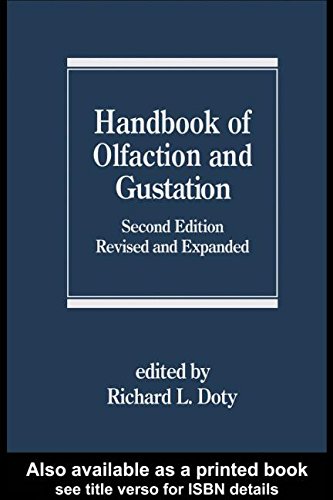From The New England Journal of Medicine:
During the past decade, the explosion of knowledge regarding the molecular and physiological basis of smell and taste has been accompanied by an increased awareness of chemosensory function in health and disease. The second edition of the Handbook of Olfaction and Gustation has grown accordingly and now contains more than 1100 pages and 48 chapters. It is a unique and unparalleled work that comprehensively brings together expertise from a variety of chemosensory disciplines into a single source containing a wealth of information about the topic. The book, edited by Richard Doty, is divided into two sections that separately cover the senses of smell and taste; those sections are further organized into subsections titled "Anatomy and Physiology," "Functional Measurement, Ontogeny, and Genetics," and "Clinical Applications and Perspectives." The chapters on anatomy, morphology, and basic physiology, which are concise and highly detailed, lay the essential groundwork for the chapters that follow. The observations by Moon and Ronnett on the molecular biology of olfactory transduction and by Gilbertson and Margolskee on the molecular physiology of gustatory transduction illustrate how modern molecular and genetic techniques can elucidate the mechanisms that underlie the senses of smell and taste; the analysis of those mechanisms reveals both shared themes and striking differences. The series of chapters that discuss the central organization of olfactory and gustatory pathways highlight current knowledge and existing theories of the complex mechanisms behind the conscious perception of odor and taste. In the subsequent sections on the measurement of chemosensory function, the book reviews the state-of-the-art methods -- electrophysiological, neuroimaging, and psychophysical -- that are used to quantify and categorize olfactory and gustatory activity in humans and animals. Included in this section are chapters on genetic and behavioral aspects of olfaction and gustation, as well as a review of artificial (electronic) nose technology. In a thought-provoking chapter, Doty explores the concept of the mammalian pheromone by reviewing the history of the term and evidence that either supports or questions its existence. Although disturbances in smell and taste are relatively common, medical educators generally do not emphasize evidence-based approaches to diagnosis and management. Therefore, physicians reading this book will find that the final subsections concerning clinical aspects of chemosensory disorders have great practical relevance. Chapters in this subsection examine in detail specific clinical conditions -- including head injury, nutritional deficiency, neurodegenerative diseases, and damage to the olfactory mucosa by toxins or viruses -- that may underlie chemosensory dysfunction. Perhaps the only notable omission in this otherwise comprehensive overview is burning mouth syndrome, which receives only a passing mention. Finally, the book goes beyond clinical topics that are directly related to olfaction or gustation to discuss multiple chemical sensitivity, vomeronasal organ function, trigeminal chemosensation, and the function of the nervus terminalis (or "0th" cranial nerve). Disorders of smell and taste are debilitating clinical problems that can have an enormous impact on the safety and quality of life. As knowledge of the basic mechanisms underlying chemosensation grows, and as diagnostic techniques for assessing chemosensory dysfunction become more sophisticated, the promise of improved treatments for these frustrating conditions may be fulfilled. For otolaryngologists, neurologists, and clinical and basic-science researchers, the Handbook of Olfaction and Gustation is an invaluable resource. Andrew P. Lane, M.D.
Copyright © 2004 Massachusetts Medical Society. All rights reserved. The New England Journal of Medicine is a registered trademark of the MMS.
Review:
...this book remains unparalleled. I highly recommend [it].
---Journal of the American Medical Association
"About this title" may belong to another edition of this title.


